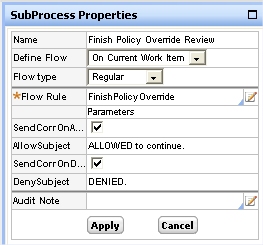Through OnChange rules and special flow rules, your application can create application-wide temporary pauses in flow processing — for example, to detect and review exceptions, suspect data or special cases — without altering the flow rules. This provides an alternative to use of tickets.
For a background on the benefits and purposes of this capability, see Understanding policy overrides and suspended work objects.
This facility requires three components:
1. Create a flow rule to support review of work objects that become suspended when the business exception occurred. On the New dialog box, select PolicyOverride in the Template field. Design the flow to meet these criteria:
This flow may be simple — containing only the Start, End Flow, and Call Subflow shapes — or it may require multiple tasks performed by multiple operators. Use the standard flow Work-.PolicyOverride as a starting point.
 2. In the SubProcess Properties
panel, complete four flow parameters for the
Work-.FinishPolicyOverride flow, to control the
e-mail correspondence it produces. You can send correspondence
when the review results in a Deny verdict, and when it results
in an Allow verdict.
2. In the SubProcess Properties
panel, complete four flow parameters for the
Work-.FinishPolicyOverride flow, to control the
e-mail correspondence it produces. You can send correspondence
when the review results in a Deny verdict, and when it results
in an Allow verdict.
The OnChange rule detects the business exception and starts the review flow.
Suspend Work Object.By default, the Work-.FinishPolicyOverride flow creates an assignment on the worklist of the operator administrator@org.com, where org.com is the organization owning the work object.
1. Override the routing activity Work-.ToPolicyOverrideOperator to route this assignment to a person (or one of a group) who is appropriate to act as a reviewer.
2. Ensure that the Operator ID of this person acquires the privilege Work-.ReviewPolicyOverrides. The standard role PegaRULES:SysAdm4 conveys this privilege, but you can create other roles appropriate to your application and organization.
Suspend Work Objects in the
Choose Action field, directly or through
forward chaining. For local flow actions — not visible
on the flow diagram — the shape appears above the
assignment.
 Each
person who acts as a reviewer must review and act on
assignments which have the status
Each
person who acts as a reviewer must review and act on
assignments which have the status
Pending-PolicyOverride. To verdict, they can
choose Allow or Deny as the flow
action.
If they choose Allow, processing resumes and
any suspended assignments reappear in worklists or workbaskets.
If they choose Deny, the work object status
changes to Resolved-Revoked. Affected users may be
notified by e-mail, if configured in the flow. In the unusual
case that two or more reviews are underway for one suspended
work object, the status changes occur only after all the
reviews are complete.
Suspended work objects remain suspended until all open reviews are completed.
To see a report of suspended work objects, select View > System > Suspended Work > In Current Work Pool.
To see a list of assignments in suspense, select View > System >Suspended Work > Assignments.
|
|
flow action, local flow action, policy override capability, ticket |
|
|
About
OnChange rules
Flow rules — Interacting with the Diagram tab |